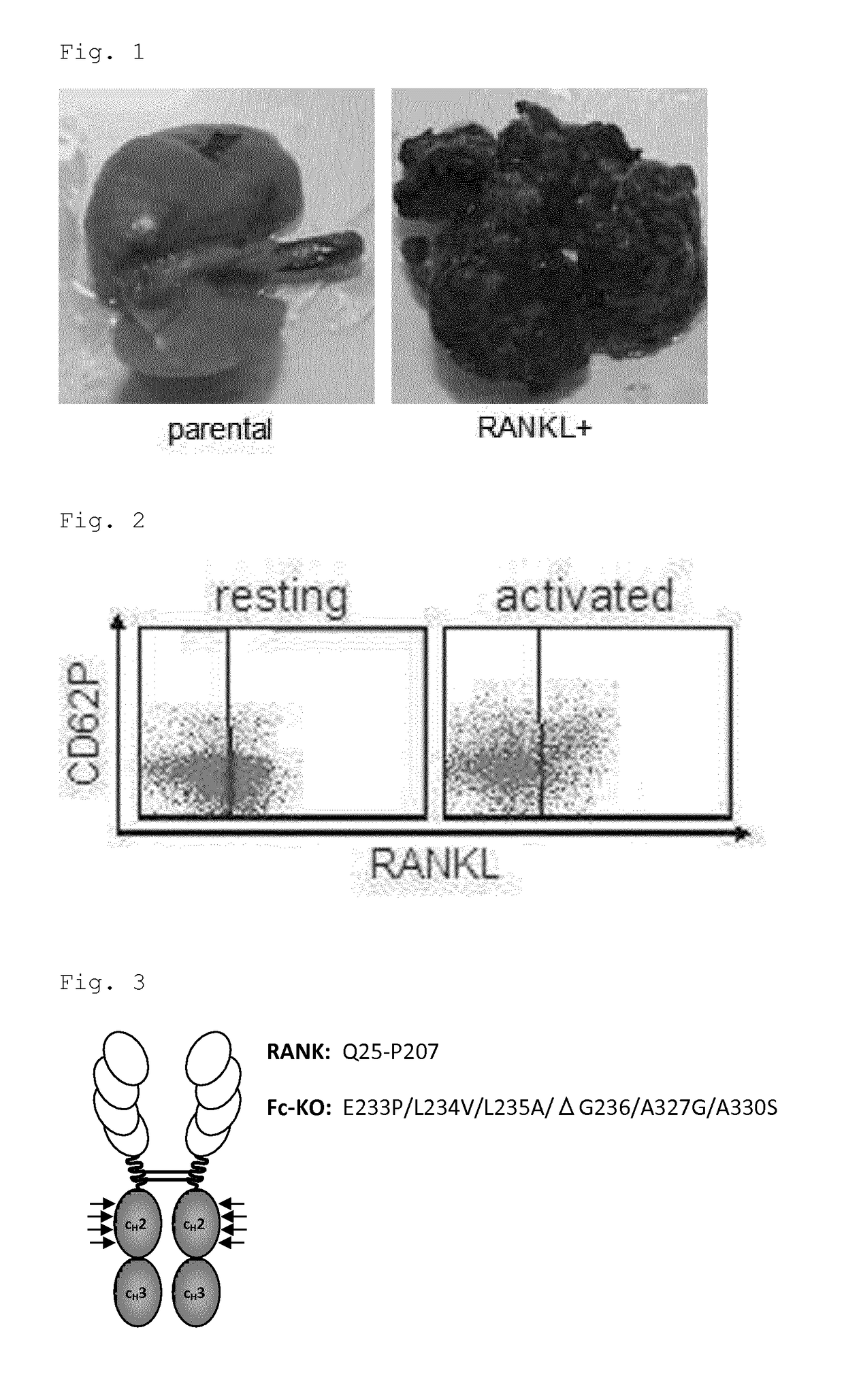Rankl-specific agent for treating metastatic disease
a technology of metastatic disease and specific agent, applied in the field ofrankl-specific antagonistic agent, can solve the problems of spinal cord compression, radiotherapy, severe disease burden and pain, etc., and achieve the effect of increasing the potential for distant metastases
- Summary
- Abstract
- Description
- Claims
- Application Information
AI Technical Summary
Benefits of technology
Problems solved by technology
Method used
Image
Examples
example 1
ression by RANKL Transfected Melanoma Cells in a Lung Metastasis Mouse Model
[0202]Mouse melanoma B16-F10 cells which were transfected with human RANKL or the parental cell line were used in a mouse model of lung metastasis. Application of transfected, RANKL-positive, cells resulted in drastically enhanced metastatic burden in the lungs of the animals as compared to the parental cells (control) (FIG. 1). Since it is known that human RANKL can stimulate mouse RANK, these data suggest that increased metastatic burden in mice which received RANKL-positive tumor cells is due to enhanced RANK signalling into the tumor cells. This is also in line with studies from Jones et al. (2006) which show enhanced metastasis of RANK-positive tumor cells upon para- and / or autocrine stimulation. This experiment proves that providing RANKL for RANK stimulation beyond the levels available under normal circumstances enhances the metastatic potential. The transfection of RANKL therein mimics the contributi...
example 2
pression on Activated Thrombocytes
[0203]Since platelets are known to promote tumor metastasis, analysis of potential RANKL surface expression on platelets was performed. While low levels of RANKL could be detected on resting platelets, profound RANKL surface expression was obtained following platelet activation with thrombin (FIG. 2). Thus, activation of platelets, which also occurs upon formation of aggregates with tumor cells, results in rapid upregulation of RANKL expression. The upregulated RANKL is then readily available to interact and stimulate RANK on tumor cells.
example 3
usion Protein
[0204]The immunoreceptor-Fc fusion protein which contains the extracellular fraction of the human receptor RANK and a human immunoglobulin G (hIgG1) was prepared (FIG. 3). The fusion protein displays markedly reduced affinity to the Fc receptor (FcγRIIIa, CD16) due to amino acid exchanges in the IgG1 part which prohibits binding of the Fc part to CD16 under physiological conditions (233P / L234V / L235A / ΔG236 / A327G / A330S, Armour et al., 1999, Schmiedel et al., 2013). This construct, in contrast to Denosumab, displays binding to both, human as well as mouse RANKL and is therefore advantageous for usage in murine models of RANKL neutralisation (Bossen et al. 2006, J Biol Chem 281(2):13964-71; Kostenuik et al. 2009, J Bone Miner Res 24(2):182-95).
PUM
 Login to View More
Login to View More Abstract
Description
Claims
Application Information
 Login to View More
Login to View More - R&D
- Intellectual Property
- Life Sciences
- Materials
- Tech Scout
- Unparalleled Data Quality
- Higher Quality Content
- 60% Fewer Hallucinations
Browse by: Latest US Patents, China's latest patents, Technical Efficacy Thesaurus, Application Domain, Technology Topic, Popular Technical Reports.
© 2025 PatSnap. All rights reserved.Legal|Privacy policy|Modern Slavery Act Transparency Statement|Sitemap|About US| Contact US: help@patsnap.com



